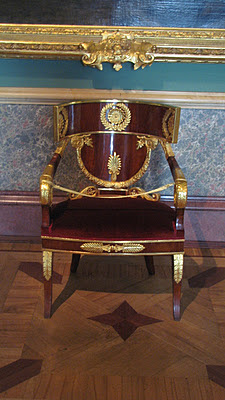THE Hermitage. Oh, my goodness. Enough is not said about this beautiful place. Growing up, I had always heard about the Lourve and The Metropolitan Museum of Art in New York. When I got older, I learned about the Musee d'Orsay across the river from the Lourve in Paris, and we lived a hop, skip, and a jump from the Art Institute in Chicago. But somehow I just glossed over the fact that The Hermitage in St. Petersburg is a major "powerhouse" in the art world! It houses around three million pieces of art in 323 galleries. If you wanted to see it all, you would have to walk about 15 miles.
The Hermitage, the former residence of many Russian monarchs, is not only full of rich history, but is an archritectural gem (like nothing else I have seen), and is full of an outstanding collection of art and culture from throughout the world.
Here's where our tour begain---The State Staircase (and surrounding area). Can you say undescribably beautiful?
 |
| This is a shot of the ceiling! |
Next, I think we walked through a long corridor (gallery) full of portraits of famous Russians or famous somebody elses! I just remember there being portraits lining the walls, but I could be totally crazy because we were in this place for three hours. It's huge, and the public only sees a small portion of it! Anyway, I snapped these next few pictures on the way to our next stop.
Our next official stop was the Hall of Peter the Great or Small Throne Room. The throne is the Silver Throne of Empress Anna Ioannovna.
On to the Armorial Hall:
The next photos show the Gallery of 1812, which is the most famous of all the memorial rooms in the palace. The 332 portraits which are on display there are of those who held the rank of general or those who were promoted to it shortly after Napoleon's army was driven from Russian soil. Even the ceiling is a work of art! The room was designed by Carlo Rossi, and the portraits were done by Englishman, George Dawe. He was in Russia for 10 years doing these portraits and others of Russian high society.
This large portrait, front and center, is the Portrait of Field Marshal Mikhail Kutuzov (like you're ever going to know that for a history or humanities class)!
The Gallery of 1812 is said to form "a fitting prelude to entering the heart of the Winter Palace---the St. George Hall" or Large Throne Room. The new throne room was created for Catherine the Great during 1787-95 in a special extension to the Winter Palace.
Here's a wonderful example of the beautiful parquet floors in the Hermitage. This one is made of 16 kinds of colorful wood:

I think this is a shot of a corridor ceiling as we moved to our next stop, but I can't figure out exactly where we went! The next shots afterwards show a collection of religious works of art:
The Pavilion Hall in the Small Hermitage:
This beautiful work of metal sculpture is the Peacock by Englishman, James Cox:
The Virgin from a scene of the Annunciation by Simone Martini:
Judith by Giorgione - 1500's:
Leonardo da Vinci's The Madonna with a Flower:
Boulle-technique doors in the Leonardo da Vinci Hall:
Leonardo da Vinci's The Madonna and Child (with some reflection off the glass!):
Titian's painting of the classical myth, Danae:
Throughout the galleries we saw a half dozen or so students who were working on their versions of the masters' works. Lucky kids:
The Raphael Loggias was built to house commissioned copies of the works of Raphael and his pupils 1516-18 which are in the loggias of the Vatican Palace. This great work of art is often referred to as Raphael's Bible. Originally in a gallery along side the Old Hermitage, it was moved to the New Hermitage in the 1800's. It reminded me of a huge patchwork quilt. It was stunning:
Another gorgeous ceiling in the Majolica Hall:
Dead Boy with Dolphin by Rapheal's student, Lorenzo Lorenzetti:
The Conestabile Madonna by Raphael (1502-03):
Crouching Boy by Michelangelo - 1530s:
The Lute-Player by Caravaggio - 1595
The Apostles Peter and Paul by El Greco - Between 1587 and 1592:
Portrait of Antonia Sarate by Francisco Goya - 1811
Rembrandt's The Holy Family - 1645:
Rembrandt's Portrait of an Old Man in Red - 1652-54:
Haman Learns his Fate by Rembrandt - 1635:
Rembrandt's Abraham's Sacrifice - 1635
Rembrandt's The Return of the Prodigal Son:
Rembrant's Portrait of a Scholar - 1631:
Rembrandt's Danae - 1636
Portrait of Anne of Austria by Simon Vouet - 1643:
Napoleon on the Bridge at Arcola by Jean Antoine Gros - 1796:
Woman (Lady) in a Garden by Claude Monet - 1867
Memory of the Garden at Etten by Vincent Van Gogh:
Vincent Van Gogh's Lilac Bush - 1889:
A peek outside into the courtyard:
Looking down in a gallery that housed gorgeous silver pieces. Don't you love the floors here, too?
A still life by Henry Matisse:
Dance of the Veils by Pablo Picasso - 1907
We walked through another area where several of the royalty's sleighs were on exhibit:
Next, a whole gallery of beautiful tapestries:
There was a whole other gallery which showcased lacquered items---amazing!
Towards the end of the tour we walked through a corridor that had huge portraits of the Russian monarchs:
Here's a picture of DJ, as we ended up right back where we began on the State Staircase. What an amazing experience this was. Even my anti-museum going husband still talks about it!
















































































































































































